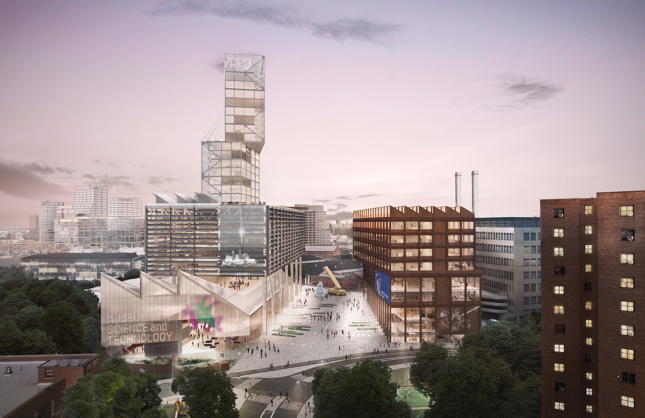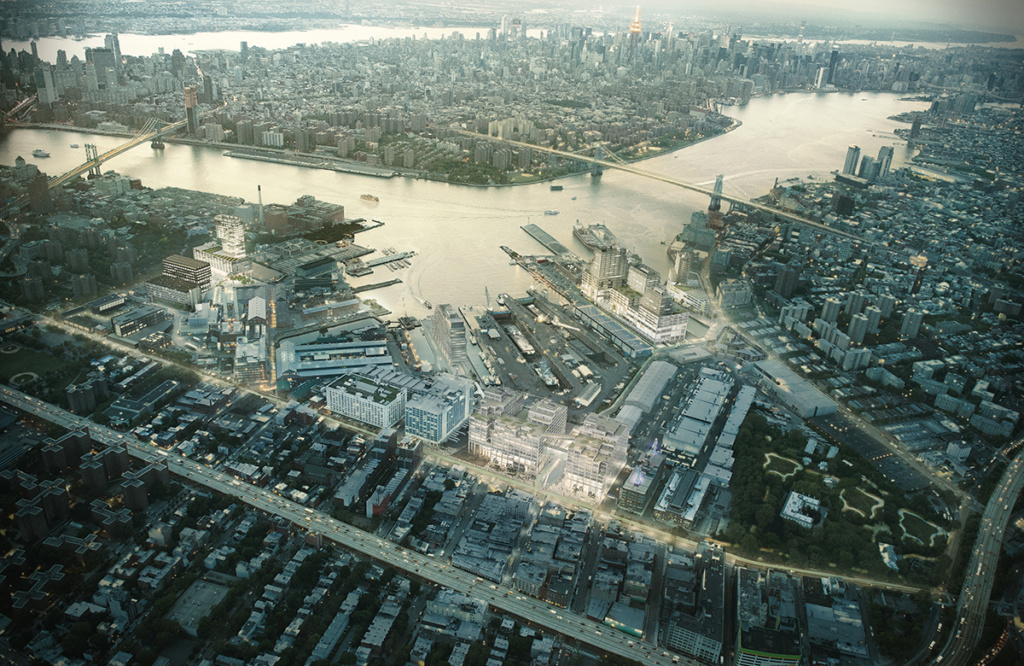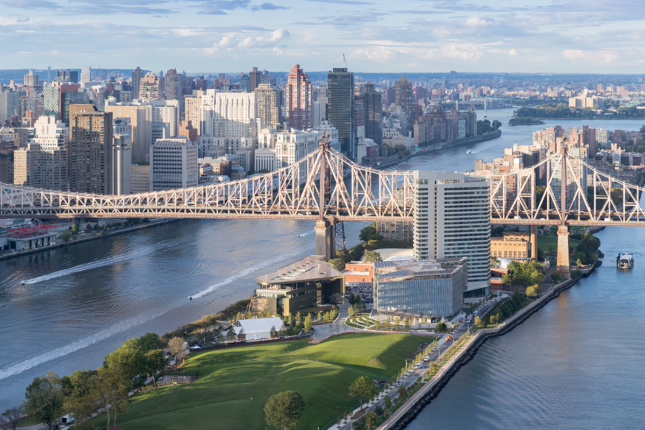In most major cities of the world, an urban tech landscape has emerged. One day, we were working on our laptops at Starbucks, and the next, we were renting desks at WeWork. We embedded our small architectural and design firms in low-rent spaces in old factories and warehouses, and then we emerged as “TAMI” (technology, advertising, media, and information) tenants, heating up the commercial real estate market. Friends who could write computer code started businesses in their apartments before moving into tech incubators and accelerators, which then morphed into a “startup ecosystem.” Though a competitive city in the 1990s might only have had one cutely named cluster of startups—New York’s Silicon Alley, San Francisco’s Media Gulch—by the 2010s, many cities were building “innovation districts.” How did this happen? And what does it mean for these cities’ futures?
The simplest explanation is that cities are catching up to the digital economy. If computers and the web are one of the primary means of production for the 21st century, all cities need the infrastructure—broadband, connectivity, flexible office space—to support them. Companies that control the means of production also need raw material—the data that newly “smart” cities can provide—to develop concepts, test prototypes, and market their wares. Local governments and business leaders have always reshaped cities around the businesses that profit from new technology; In the 19th century, they built railroad stations, dug subway tunnels, and laid sewage pipes; in the 20th century, they wired for electricity and erected office towers. Maybe we should ask why it has taken cities so long to rebuild for digital technology.
Inertia is one answer, and money is another. Entrenched elites don’t readily change course, especially if a new economy would challenge their influence on local politics and labor markets. Think about the long dominance of the auto industry in Detroit and the financial industry in New York, both late converts to digital technologies like self-driving cars and electronic banking, respectively.
Another reason for cities’ slow awakening to the tech economy is the post–World War II prominence of suburban office parks and research centers, part of the mass suburbanization of American society. On the East Coast, tech talent began to migrate from cities in the early 1940s, when Bell Labs, the 20th-century engineering powerhouse, moved from Lower Manhattan to a large tract of land in suburban New Jersey. A few years later, on the West Coast, Stanford University and the technology company Varian Associates spearheaded the construction of an electronics research park on a university-owned site of orange groves that later became known as Silicon Valley.
Silicon Valley got the lion’s share of postwar federal government grants and contracts from the military for microwave electronics innovation, missile research, and satellite communications. Venture capital (VC) soon followed. Although VC firms began in New York and Boston, by the 1960s and ’70s they were setting up shop in the San Francisco Bay Area.
The Valley’s hegemony was solidified in the 1980s by the rise of the personal computer industry and the VCs who got rich by investing in it. The suburban tech landscape so artfully represented in popular mythology by Silicon Valley’s DIY garages and in physical reality by its expansive corporate campuses was both pragmatically persuasive and culturally pervasive. Its success rested on a triple helix of government, business, and university partnerships, defining an era from Fairchild, Intel, and Hewlett-Packard (the first wave of major digital technology companies) to Apple, Google, and Facebook.
In contrast to the suburban postwar growth of Silicon Valley, the urban tech landscape was propelled by the rise of software in the early 2000s and gained ground after the economic crisis of 2008. Software was easier and cheaper to develop than computers and silicon chips—it wasn’t tied to equipment or talent in big research universities. It was made for consumers. Most important, with the development of the iPhone and the subsequent explosion of social media platforms after 2007, software increasingly took the form of apps for mobile devices. This meant that software startups could be scaled, a crucial point for venture capital. For cities, however, the critical point was that anyone, anywhere, could be both an innovator and an entrepreneur.
The 2008 economic crisis plunged cities into a cascade of problems. Subprime mortgages cratered, leaving severely leveraged households and financial institutions adrift. Banks failed if they didn’t get United States government lifelines. Financial jobs at all levels disappeared; local tax revenues plummeted. While mayors understood that they had to end their dependence on the financial sector—a realization most keenly felt in New York—they also faced long-term shrinkage in manufacturing sectors and office vacancies.
London had already tried to counter deindustrialization with the Docklands solution: Waterfront land was redeveloped for new media and finance, and unused piers and warehouses were converted for cultural activities. In Spain, this strategy was taken further in the 1990s by the construction of the Guggenheim Bilbao museum and the clearing of old industrial plants from that city’s waterfront. By the early 2000s, Barcelona’s city government was building both a new cultural district and an “innovation district” for digital media, efforts that bore a striking resemblance to the 1990s market-led development of the new media district in Manhattan’s Silicon Alley and the growth of tech and creative offices in Brooklyn’s DUMBO neighborhood.

Until the economic crisis hit, both spontaneous and planned types of urban redevelopment were connected to the popular “creative city” model promoted by Charles Landry in London and Richard Florida in Pittsburgh (later, Toronto). In 2009, however, economic development officials wanted a model that could create more jobs. They seized on the trope of “Innovation and Entrepreneurship” that had been circulating around business schools since the 1980s, channeling the spirit of the economic historian Joseph Schumpeter and popularized in a best-selling book by that title by the management guru Peter Drucker. Adopted by researchers at the Brookings Institution, urban innovation districts would use public-private partnerships to create strategic concentrations of workspaces for digital industries. It seemed like a brilliant masterstroke to simultaneously address three crucial issues that kept mayors awake at night: investments, jobs, and unused, low-value buildings, and land.
In the absence of federal government funding, real estate developers would have to be creative. They built new projects with money from the city and state governments, the federal EB-5 Immigrant Investor Visa Program for foreign investors, and urban impact funding that flowed through investment banks like Goldman Sachs. Federal tax credits for renovating historic buildings and investing in high-poverty areas were important.
Though all major cities moved toward an “innovation economy” after 2009, New York’s 180-degree turn from finance to tech was the most dramatic. The bursting of the dot-com bubble in 2000 and 2001, followed by the September 11 attack on the World Trade Center and an economic recession, initially kept the city from endorsing the uncertainty of tech again. Michael Bloomberg, mayor from 2001 to 2013, was a billionaire whose personal fortune and namesake company came from a fusion of finance and tech, most notably the Bloomberg terminal, a specially configured computer that brings real-time data to stock brokers’ and analysts’ desks. Yet, as late as 2007, Mayor Bloomberg, joined by New York’s senior senator Chuck Schumer, promoted New York as the self-styled financial capital of the world, a city that would surely triumph over its only serious rival, London. The 2008 financial crisis crumpled this narrative and turned the Bloomberg administration toward tech.
By 2009, the city’s business elites believed that New York’s salvation depended on producing more software engineers. This consensus motivated the mayor and his economic development officials to build big, organizing a global competition for a university that could create a dynamic, postgraduate engineering campus in New York. Cornell Tech emerged as the winner, a partnership between Cornell University and the Israel Institute of Technology. Between 2014 and 2017, the new school recruited high-profile professors with experience in government research programs, university classrooms, and corporate labs. They created a slew of partnerships with the city’s major tech companies, and the resulting corporate-academic campus made Roosevelt Island New York’s only greenfield innovation district. Not coincidentally, the founding dean was elected to Amazon’s board of directors in 2016.
The Bloomberg administration also partnered with the city’s public and private universities, mainly the aggressively expanding New York University (NYU), to open incubators and accelerators for tech startups. After NYU merged with Polytechnic University, a historic engineering school in downtown Brooklyn, the Bloomberg administration made sure the new engineering school could lease the vacant former headquarters of the Metropolitan Transportation Authority nearby, where NYU’s gut renovation created a giant tech center.
Meanwhile, the Brooklyn waterfront was booming. The Brooklyn Navy Yard added advanced manufacturing tenants and art studios to its traditional mix of woodworking and metalworking shops, food processors, and suppliers of electronics parts, construction material, and office equipment, and began to both retrofit old machine shops for “green” manufacturing and build new office space. While tech and creative offices were running out of space in DUMBO, the heads of the downtown Brooklyn and DUMBO business improvement districts came up with the idea of marketing the whole area, with the Navy Yard, as “the Brooklyn Tech Triangle.” With rezoning, media buzz, and a strategic design plan, what began as a ploy to fill vacant downtown office buildings moved toward reality.
Established tech companies from Silicon Valley and elsewhere also inserted themselves into the urban landscape. Google opened a New York office for marketing and advertising in 2003 but expanded its engineering staff a few years later, buying first one, then two big buildings in Chelsea: an old Nabisco bakery and the massive former headquarters of the Port Authority of New York and New Jersey. Facebook took AOL’s old offices in Greenwich Village. On the next block, IBM Watson occupied a new office building designed by Fumihiko Maki.
Jared Kushner’s brother, the tech investor Jonathan Kushner, joined two other developers to buy the Jehovah’s Witnesses’ former headquarters and printing plant on the Brooklyn-Queens Expressway. The developers converted the buildings into tech and creative offices and called the little district Dumbo Heights. By 2015, the growth of both venture capital investments and startups made New York the second-largest “startup ecosystem” in the world after Silicon Valley. Within the next three years, WeWork (now the We Company) surpassed Chase Bank branches as Manhattan’s largest commercial tenant.
Cornell Tech, a partnership between Cornell University and the Israel Institute of Technology, was a Bloomberg initiative that made Roosevelt Island New York’s only greenfield innovation district. (Courtesy Iwan Baan)
All this development was both crystallized and crucified by Amazon’s decision to open half of a “second” North American headquarters (HQ2) in the Long Island City neighborhood of Queens, New York, in 2018. Amazon organized a competition similar to the Bloomberg contest that resulted in Cornell Tech, but in this case, the contest was a bidding war between 238 cities that offered tax credits, help with land assemblage, and zoning dispensations in return for 50,000 tech jobs that the company promised to create. But in announcing its selection, Amazon divided the new headquarters in two, supposedly placing half the jobs in New York and the other half in Crystal City, Virginia, a suburb of Washington, D.C. Many New Yorkers erupted in protest rather than celebration.
The amount of tax credits offered to the very highly valued tech titan, almost $3 billion in total, appeared to rob the city of funding for its drastic needs: fixing the antiquated subway system, repairing the aging public housing stock, and building affordable housing. The decision-making process, tightly controlled by Governor Andrew Cuomo and Mayor Bill de Blasio, enraged New York City Council members, none of whom had been given a role in either negotiating or modifying the deal. The deal itself was closely supervised by New York State’s Economic Development Corporation behind closed doors, without any provision for public input or approval.
Housing prices in Long Island City rose as soon as the deal was announced. A city economic development representative admitted that perhaps half of the jobs at HQ2 would not be high-paying tech jobs, but in human resources and support services. In a final, painful blow, Amazon promised to create only 30 jobs for nearly 7,000 residents of Queensbridge Houses, the nearby public housing project that is the largest in the nation.
Amazon representatives fanned their opponents’ fury at public hearings held by the New York City Council. They said the company would not remain neutral if employees wanted to unionize, and they refused to offer to renegotiate any part of the deal. Opponents also protested the company’s other business practices, especially the sale of facial recognition technology to the U.S. Immigration and Customs Enforcement agency (ICE). Yet surveys showed that most registered New York City voters supported the Amazon deal, with an even higher percentage of supporters among Blacks and Latinos. Reflecting the prospect of job opportunities, construction workers championed the deal while retail workers opposed it. The governor and mayor defended the subsidies as an investment in jobs. Not coincidentally, Amazon planned to rent one million square feet of vacant space in One Court Square, the former Citigroup Building in Long Island City, before building a new campus on the waterfront that would be connected by ferry to Cornell Tech.
After two months of relentless, vocal criticism, in a mounting wave of national resentment against Big Tech, Amazon withdrew from the deal. Elected officials blamed each other, as well as a misinformed, misguided public for losing the economic development opportunity of a lifetime.
Yet it wasn’t clear that landing a tech titan like Amazon would spread benefits broadly in New York City. A big tech company could suck talent and capital from the local ecosystem, deny homegrown startups room to expand, and employ only a small number of “natives.”
From San Francisco to Seattle to New York, complaints about tech companies’ effect on cities center on privatization and gentrification. In San Francisco, private buses ferry highly paid Google workers from their homes in the city to the company’s headquarters in Silicon Valley, green space and cafes in the Mid-Market neighborhood proliferate to serve Twitter employees and other members of the technorati, low-income Latinos from the Mission district are displaced by astronomical rents—all of these factors stir resentment about Big Tech taking over. In Seattle, Amazon’s pressure on the city council to rescind a tax on big businesses to help pay for homeless shelters also aroused critics’ ire. Until recently, moreover, tech titans have been unwilling to support affordable housing in the very markets their high incomes roil: East Palo Alto and Menlo Park in California, and Redmond, Washington.
It remains to be seen whether urban innovation districts will all be viable, and whether they will spread wealth or instead create highly localized, unsustainable bubbles. Venture capital is already concentrated in a small number of cities and in a very few ZIP codes within these cities. According to the MIT economist David Autor, although the best “work of the future” is expanding, it is concentrated in only a few superstar cities and only represents 5 percent of all U.S. jobs.
Yet urban tech landscapes emerge from a powerful triple helix reminiscent of Silicon Valley. Elected officials promise jobs, venture capitalists and big companies make investments, and real estate developers get paid. Though these landscapes glitter brightly compared to the dead spaces they replace, they don’t offer broad participation in planning change or the equitable sharing of rewards.
Sharon Zukin is a Professor of Sociology at the City University of New York, Brooklyn College, and is author of the forthcoming book The Innovation Complex: Cities, Tech, and the New Economy.

